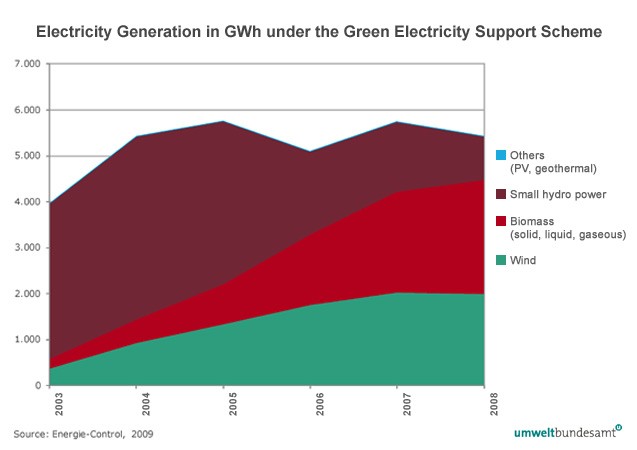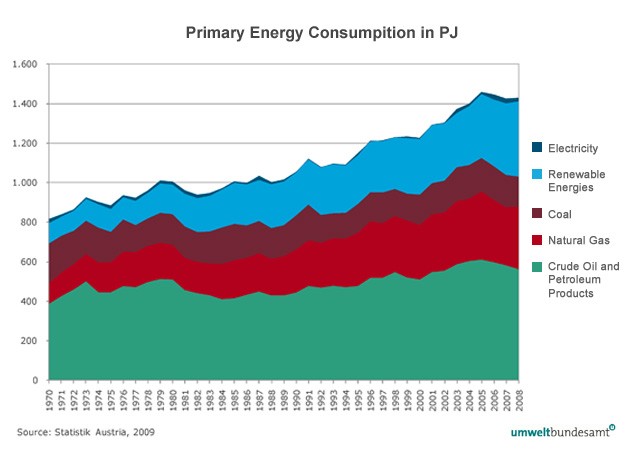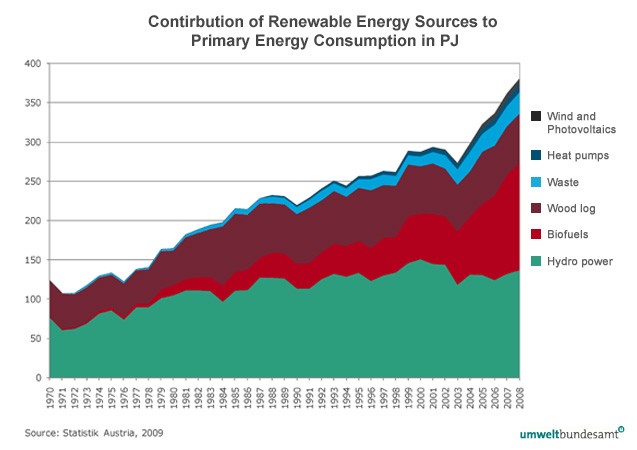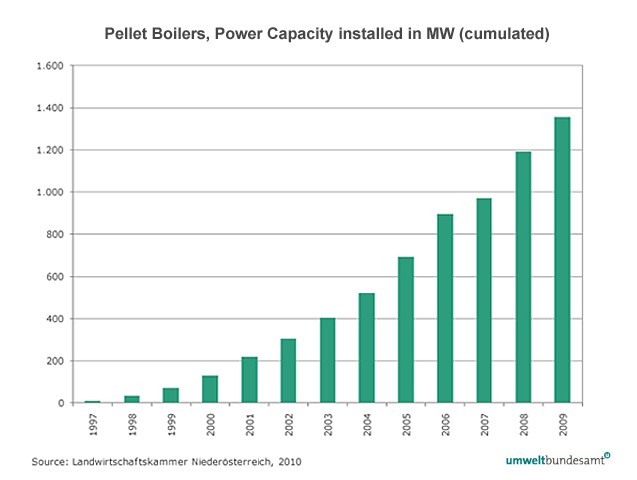Austria: Austria Renewable Energy Profile 2011
2011/07/03
Austria ranks high in renewable energy consumption, mainly due to its high share in hydropower and biomass. It was among the four EU countries with the highest share of energy from renewable sources in gross final energy consumption in 2005 and amongst the Member States committing to the most ambitious national targets for 2020 (in Austria: 34%) under the EU Directive 2009/28/EC on the promotion of the use of energy from renewable sources. Since 2005 the share of renewable energy in Austria had grown continuously, reaching nearly 29% in 2008. The main driver for the growing contribution of renewable energy is the enhanced use of biomass due to strong incentives such as targets set by regulations, a longterm focus on research and development policies as well as subsidies.
Biomass for Space Heating
Wood biomass for heating purposes has always played an important role in the Austrian energy supply. In the beginning of the 1980s, strict air pollution legislation was introduced, forcing companies to improve the performance of wood boilers with regard to energy efficiency and emissions. Strong competition started which resulted in significant improvements and highperformance biomass combustion technologies. Hence, biomass boilers made in Austria nowadays represent one of the best available biomass combustion technologies worldwide. As regards consumers, grants for wood boilers stimulated demand. In 2009, more than 70 000 pellet boilers were installed with a power capacity of 1,356 MW.
Over 1,000 biomass district heating stations have been constructed in rural areas since the 1980s, often with subsidies providing the decisive incentive.
Biomass for Electricity Generation
Green electricity legislation was introduced in 2002 pursuant to the EU Directive 2001/77/EC on the promotion of electricity produced from renewable energy sources, regulating eligibility of support and feedin tariffs. In 2009 , electricity produced from biomass under the green electricity scheme accounted to more than 2,500 GWh corresponding to around 5% of total electricity production.
Biofuels for Transport
In 2004, Austria's government adopted an ordinance on biofuels exceeding the targets of EU Directive 2003/30/EC (2% share in 2005, 5.75% in 2010) resulting in a 7% share of biofuels in 2009.
Outlook
The objective of the (recently elaborated) energy strategy is the development of an energy system providing energy services to private consumers and businesses in the future while complying with EU climate and energy requirements (34% renewables, 16% reduction of GHG in the nonETS sector). Achieving stabilisation of final energy consumption (considered to be indispensable) is a major challenge for Austria.
According to recent national research papers, main challenges in the energy sector are achieving a higher rate of thermal refurbishment of existing buildings, a new approach to transport and mobility services and a higher rate of cogeneration and renewables in the production sector as well as future decisionmaking on energy supply and transformation technologies and increased public research funds for clean energies.
EUDirective Renewables with national target for Austria: EUROPISCHE UNION (2009): Directive 2009/28/EC of the European Parliament and of the council of 23 April 2009 on the promotion of the use of energy from renewable sources and amending and subsequently repealing Directives 2001/77/EC and 2003/30/EC.




- Related Articles
-
Austria Fishery and Aquaculture Country Profiles
2012/01/01 更多 document.getElementById("bdshell_js").src = "http://share.baidu.com/static/js/shell_v2.js?t=" + new Date().getHours(); -
Austria Inflation Rate
2011/09/24 var addthis_config = { pubid: "YOUR PROFILE ID" } -
Imports
2011/09/24 var addthis_config = { pubid: "YOUR PROFILE ID" } -
Austria Exports
2011/09/24 var addthis_config = { pubid: "YOUR PROFILE ID" } Austria Exports -
Austria Current Account to GDP
2011/09/24 var addthis_config = { pubid: "YOUR PROFILE ID" }
-
- Austria News
-
- AUSTRIA: Austria Private Sector Growth Maintains Strong Momentum
- AUSTRIA: OPEC, non-OPEC agree first global oil pact since 2001
- AFGHANISTAN: Higher earning Why a university degree is worth more in some countries than others
- AUSTRIA: Minister Nkoana-Mashabane to host her Austrian counterpart
- ALBANIA: Europe in 2016: Terror fears, migration, politics. But economy may turn a corner
- AFGHANISTAN: Global growth will be disappointing in 2016: IMF's Lagarde
- Trending Articles
-
- QATAR: Qatar focuses on preventive care in new national health strategy
- SOUTH AFRICA: South Africa targets increased investment for food and beverages
- CHINA: Why China and Russia will be best frenemies forever
- CHINA: China energy regulator raises targets for curbing coal-fired power
- UNITED STATES: EU's Juncker says ready to retaliate if needed over new U.S. sanctions on Russia
- NIGERIA: The Federal Government Begs Dangote to Complete Refinery Before 2019








